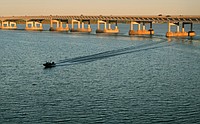The big yellow machines began arriving last week along Union Pacific's railroad tracks in Atlanta.
There were 15 to 18 of them, not counting pickups and wagons.
Their mission was to replace thousands of crossties and service the track between Jefferson, Texas, and Hope, Arkansas.
Unionized crews were ready to operate the complex machines with a high level of skill and efficiency.
They had to be. Working around railroad tracks is not a child's game. UP's latest length of train is likely to be 200-plus cars being pulled by five locomotives and requiring 8 to 10 minutes to pass.
These behemoths at the top of the transportation food chain are on a timing schedule and still coming through.
The yellow crosstie machines, big as they are, have just a certain length of time to replace those ties, cultivate the ballast rock, align the rails with perfection and get out of the way.
The work crews have had their morning instruction meeting and prayer.
Prayer? Yes, it's a little-known fact about many railway unions and other working groups.
In such a dangerous and critical environment, employees have to trust one another, their maker and themselves. And so they pray individually and together.
Ralph Holmes of Baton Rouge, Louisiana, lead signalman on this crosstie crew, said this about his prayers each workday morning.
"Every morning, before I leave the hotel, I say thank you for the safe travel here, and then once here when we are at the site for our job description meeting, we say a group prayer for the days' work, home, family and travel. We thank the Lord for waking us up safely."
To the city onlooker - passing motorist, perhaps - this railroad work seems mysterious. The UP workmen appear calm. And the numerous road safety personnel standing outside the track and are relaxed but ready to block all motor vehicle traffic. All important railroad signals are off. For a certain length of time, no trains are coming through, and the track repair work is under way. Crossties are replaced in a quick, smooth and professional manner.
But to grasp what's going on, it's necessary to know the machinery doing the work. Here's a machine-by-machine, step-by-step description.
The first thing to know is that before the yellow machines arrive, preparations have been made.
Preparation
New crossties arrive by train and are unloaded and placed next to the tracks. Safety crews go out and mark with paint each crosstie to be replaced. A first machine comes by to make sure the correct number of crossties have been placed and then uses a long arm to lift and line up the end of the new tie with the end of the old tie under the rails.
Work Starts
The second machine now pulls out the crosstie spikes. A third machine picks up spikes with a magnet and dumps them into a bin.
A fourth machine lifts rails and punches out old crossties, but leaves spike plates in place. Hand crews pick up and replace the spike plates using tools from a flat-bed trailer.
A fifth machine with a long arm moves the old crossties to sideline. A sixth machine places metal bars in place on track to keep crossties from sliding along rails. A seventh machine spaces crossties properly.
An eighth machine widens the hole which held the old crosstie. The ninth machine reaches out and lines up new crosstie and pushes the new crosstie in place under rail.
Finishing Up
Other types of machines now reach around and under crossties and use vibrating "fingers" to push rocks in place. Spike plates are then screwed into the wooden crosstie and metal bars are cinched closely to the plate to keep the crosstie in place. The track rails are raised while most of this adjustment work goes on.
The ballast regulating machine begins passing back and forth, placing rocks around and under the crossties. Brush sweepers then sweep area clean. Track rails are smooth and clear.
A small cart device is pushed along track by hand, using laser light beams to show if the track is perfectly level.
The largest and last machine of all is able to lift and level track, positioned using the red laser. The ballast machine goes over the track area again.
All of the activities above are essentially been done by hydraulic pressure implements under hand control. This equipment must be kept in order, so crosstie crews carry a full range of replacement parts and mechanics are able to repair any breakdown.
To see a crosstie operation in action, one has to look closely, quickly and attentively. The work goes by rapidly but not in a hurry. The crosstie replacement operation in downtown Atlanta last week - including one extensive repair of the crossing at North East and Allday Streets - was completed in just several hours.


